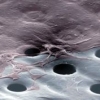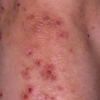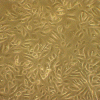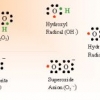Nove su 10 lettini abbronzanti, in Inghilterra, emettono livelli di radiazione ultravioletta che superano i limiti di sicurezza vigenti
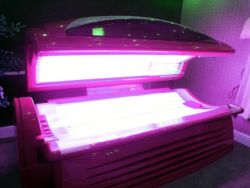 L'esposizione ai raggi ultravioletti (UV) della luce solare è riconosciuta come causa principale del cancro alla pelle. Inoltre, i lettini abbronzanti sono stati classificati come cancerogeni dall'Agenzia Internazionale per la Ricerca sul Cancro. Nonostante questo, vi è una carenza di dati oggettivi sui livelli di esposizione ai raggi UV dei lettini abbronzanti in Inghilterra.
L'esposizione ai raggi ultravioletti (UV) della luce solare è riconosciuta come causa principale del cancro alla pelle. Inoltre, i lettini abbronzanti sono stati classificati come cancerogeni dall'Agenzia Internazionale per la Ricerca sul Cancro. Nonostante questo, vi è una carenza di dati oggettivi sui livelli di esposizione ai raggi UV dei lettini abbronzanti in Inghilterra.
Obiettivi: Abbiamo deciso di misurare i livelli di emissione UV dei lettini abbronzanti in siti diversi dell'Inghilterra, e di confrontare questi livelli sia con le norme in vigore che con luce solare naturale.
Metodi: Tra l'Ottobre 2010 e il Febbraio 2011, gli spettri UV sono stati misurati in un totale di 402 unità abbronzanti artificiali, in Inghilterra. È stata calibrata la strumentazione di misura, riconducibile al National Physical Laboratory. È stata determinata la conformità alle norme inglesi ed europee, ed è stato utilizzato un fattore di ponderazione per il cancro alla pelle al fine di confrontare il potenziale cancerogeno dei lettini abbronzanti con quello della luce solare.
Risultati: In conformità alla norma europea, l'irradianza efficace sull'eritema non deve essere superiore a 0·3 W m−2. I valori che abbiamo misurato sono stati compresi in un range tra 0·10 e 1·32 W m−2 con una media di 0·56 ± 0·21 W m−2. Solo il 10% dei lettini abbronzanti indagati non aveva il limite consigliato. L'applicazione del fattore di ponderazione per il cancro alla pelle ha prodotto dei valori che variavano da 0·17 to 2·52 W m−2, con una media di 0·99 ± 0·41 W m−2. Il valore comparabile per il sole di mezzogiorno nel Mediterraneo è stato di 0·43 W m−2.
Conclusioni: Nove su 10 lettini abbronzanti, tra quelli sondati in tutta l'Inghilterra, hanno emesso livelli di radiazioni UV superiori a quelli massimi consentiti dalla norma Europea. Inoltre, il rischio di cancro alla pelle per tempi di esposizione comparabili è stato fino a sei volte superiore rispetto alla luce solare mediterranea. Questa situazione è inaccettabile e devono essere messe in atto delle misure di controllo più restrittive.
Storia della pubblicazione:
Titolo: Nine out of 10 sunbeds in England emit ultraviolet radiation levels that exceed current safety limits
Rivista: British Journal of Dermatology. doi: 10.1111/bjd.12181
Autori: P. Tierney, J. Ferguson, S. Ibbotson, R. Dawe, E. Eadie, H. Moseley
Affiliazioni: The Photobiology Unit, Ninewells Hospital and Medical School, University of Dundee, Dundee DD1 9SY, U.K.
Abstract:
Background Exposure to ultraviolet (UV) radiation from sunlight is recognized as the principal cause of skin cancer. Moreover, sunbeds have been classified as carcinogenic by the International Agency for Research on Cancer. Despite this, there is a shortage of objective data on UV exposure levels in sunbeds in England.
Objectives We set out to measure UV emission levels in sunbeds at sites around England, and to compare these levels with both current standards and natural sunlight.
Methods Between October 2010 and February 2011, UV spectra were measured on site from a total of 402 artificial tanning units in England. Measurement instrumentation was calibrated, traceable to the National Physical Laboratory. Compliance with the relevant British and European standard was determined, and a skin-cancer weighting factor was used to compare the carcinogenic potential of sunbeds with that of sunlight.
Results For compliance with the European standard, erythemal-effective irradiance should not exceed 0·3 W m−2. The values that we measured ranged between 0·10 and 1·32 W m−2 with a mean of 0·56 ± 0·21 W m−2. Only 10% of sunbeds surveyed were within the recommended limit. Application of the skin-cancer weighting factor produced values that varied from 0·17 to 2·52 W m−2 with a mean of 0·99 ± 0·41 W m−2. The comparable value for Mediterranean noonday sun was 0·43 W m−2.
Conclusions Nine out of 10 sunbeds surveyed throughout England emitted levels of UV radiation that exceed the maximum levels contained within the European standard. Moreover, the skin cancer risk for comparable times of exposure was up to six times higher than that for Mediterranean sunlight. This situation is unacceptable and stricter control measures must be put in place.

